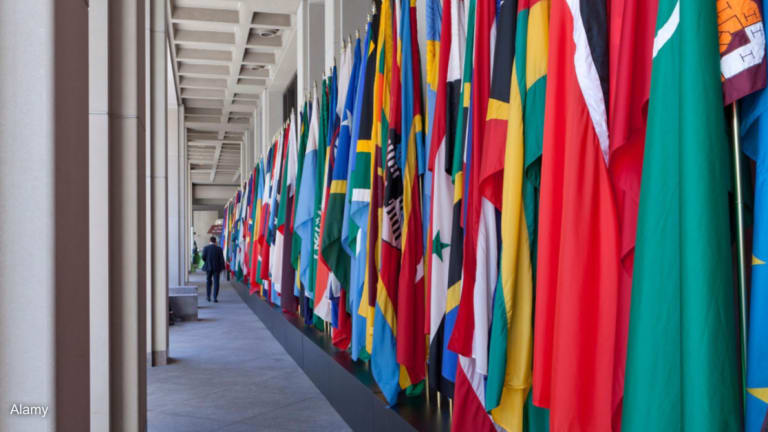How did the UN spend $22.3B in 2020?
Devex digs into the United Nations' "Annual Statistical Report" to see how the organization spent its budget, what sectors were prioritized, and who the biggest suppliers were.
This month the United Nations released its “Annual Statistical Report,” detailing procurements from 39 organizations within the U.N. system in 2020. Together, these organizations spent the highest procurement volume to date worth $22.3 billion — up by 12.3% compared to 2019. With $1.7 billion total spendings, the World Health Organization had the largest increase at 92.3% compared to its 2019 spending. UNICEF remained the biggest spender at $4.5 billion, or 20% of U.N.’s total procurement. The United Nations Development Programme also had a significant increase at 23.1%, for a total of $2.6 billion in spendings. For the first time since 2011, the priority shifted to the procurement of goods — with $11.7 billion compared to the $10.6 billion spent on services. This increase was largely driven by the procurement of goods and services related to pandemic response. Overall, 38 U.N. organizations spent $2.1 billion on the COVID-19 response. WHO’s COVID-19 procurement was the highest at $750 million, of which $308 million went to medical equipment and $221 million went to laboratory and testing equipment. Procurement by organization Five organizations accounted for 67%, or $15.1 billion, of the U.N.'s total procurement in 2020: UNICEF, World Food Programme, UNDP, the United Nations Procurement Division, and WHO. Across these organizations, the increase in spending can be attributed to the procurement of medical equipment, management, and administrative services, and laboratory and testing equipment mainly for COVID-19 response. While the pandemic boosted spending for some agencies, others were adversely impacted. Among them, the International Telecommunication Union recorded the biggest dip relative to its total procurement spending in 2019 — 61.1% or $30 million — which was driven by a change in health insurance providers. The International Organization for Migration and UNPD also reported a decrease in procurement, especially in the travel sector, as a result of COVID-19. IOM’s procurement decreased by 19%, or $182 million, while UNPD’s decreased by 7.2%, or $181 million. Procurement by sector Health was prioritized among the procurement sectors with $5.5 billion in spending — a 25.5% increase from 2019. Pharmaceuticals, contraceptives, and vaccines were the most funded overall at $3 billion, while medical equipment followed at $2.2 billion. UNICEF alone accounted for 49.4% of the total health procurements. Other sectors with significant spending include construction, engineering, and science at $3 billion, food and farming at $2.5 billion, transportation and storage at $2.3 billion, and administration and operations at $2.1 billion. Construction, engineering, and science had the biggest increase at 27.1%, while travel, accommodation, and catering service slashed its spending by 46.3%. Top suppliers Half of the U.N.'s top 10 suppliers were Organisation for Economic Co-operation and Development member countries: the United States, Denmark, France, Switzerland, and Belgium. Together, they supplied more than $5.2 billion worth of goods and services or 23.3% of the agency’s total spending. The other half of the top suppliers are low- to upper-middle-income countries, which received more than $4 billion or 18% of U.N.’s procurement in 2020. To date, this is the largest total procurement volume from these countries. This could be easily linked to the surge in the procurement of goods from Chinese suppliers, which were contracted to provide $672 million worth of medical equipment to UNICEF, WHO, and UNDP. While the U.S. maintained its spot as U.N.'s main supplier, providing over $1 billion in services, China saw the biggest jump — from the twentieth place in 2019 to third place in 2020 with $880 million in goods and $135 million in services. Other countries that made the top suppliers list were India at $947 million, United Arab Emirates at $790.5 million, Yemen at $678.3 million, and Kenya at $597.1 million. Overall, the U.N. procured 62%, or $13.7 billion of its spending, from suppliers in the developing world, countries with economies in transition, and low-income countries. WFP had the largest procurement volume supplied from these groups of countries: 75.2% of their $4 billion in spending. According to U.N. data, 4 out of the top 5 suppliers to the U.N. in 2020 were pharmaceutical companies. GlaxoSmithkline received the biggest contract at $292 million. Pfizer follows with $255 million, and the Serum Institute of India with $211 million. Sanofi in France also received $166 million. All four contracts were procured by UNICEF. A few major contracts for pharmaceuticals, vaccines, and contraceptives procured by PAHO and WHO, ranging in value from $106.5 million to $236.7 million, did not include the name of the supplier for security reasons. Tristar Group, an energy logistics company based in the UAE, was the top U.N. supplier outside the health sector. It received over $230 million from UNDP. Try out Devex Pro Funding today with a free 5-day trial, and explore funding opportunities from over 850+ sources in addition to our analysis and news content.
This month the United Nations released its “Annual Statistical Report,” detailing procurements from 39 organizations within the U.N. system in 2020. Together, these organizations spent the highest procurement volume to date worth $22.3 billion — up by 12.3% compared to 2019.
With $1.7 billion total spendings, the World Health Organization had the largest increase at 92.3% compared to its 2019 spending. UNICEF remained the biggest spender at $4.5 billion, or 20% of U.N.’s total procurement. The United Nations Development Programme also had a significant increase at 23.1%, for a total of $2.6 billion in spendings.
For the first time since 2011, the priority shifted to the procurement of goods — with $11.7 billion compared to the $10.6 billion spent on services. This increase was largely driven by the procurement of goods and services related to pandemic response. Overall, 38 U.N. organizations spent $2.1 billion on the COVID-19 response.
This story is forDevex Promembers
Unlock this story now with a 15-day free trial of Devex Pro.
With a Devex Pro subscription you'll get access to deeper analysis and exclusive insights from our reporters and analysts.
Start my free trialRequest a group subscription Printing articles to share with others is a breach of our terms and conditions and copyright policy. Please use the sharing options on the left side of the article. Devex Pro members may share up to 10 articles per month using the Pro share tool ( ).
Miguel Tamonan is a Senior Development Analyst at Devex, where he analyzes data from public and private donors to produce content and special reports for Pro and Pro Funding readers. He has a bachelor’s degree in Political Science with a Major in International Relations from the Polytechnic University of the Philippines.
Raquel Alcega leads the data research and analysis at Devex, providing advice to organizations on the latest funding and programmatic trends that shape the global development space. She also heads up the news business content strategy and designs internal knowledge management processes. Prior to joining Devex’s Barcelona office, she worked in business development in Washington, D.C., and as a researcher in Russia and Mexico.





